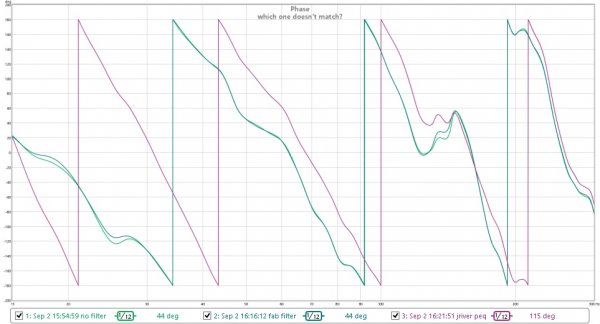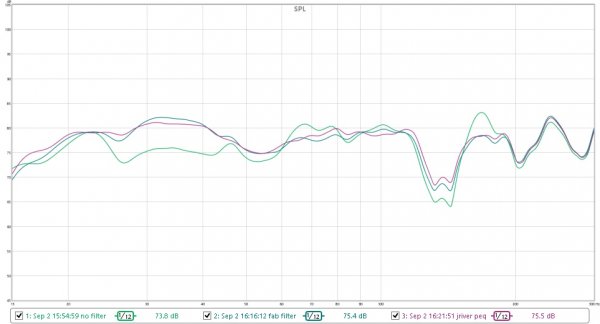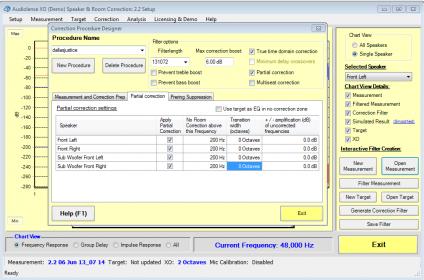I have the fab filter pro q plugin for jriver. I had forgotten I had it since my last effort with filters wasn't nearly this successful. Nyal recommended I use the same filters I use with jriver's PEQ in fab filter pro q. Since there are 14 bands, this took a while. I set fab filter to max latency-linear phase. There is no question the filters sound better using fab filter! The bass sounds crisper and better defined. Winner!
IIR vs. FIR filters in Jriver
- Thread starter dallasjustice
- Start date
You are using an out of date browser. It may not display this or other websites correctly.
You should upgrade or use an alternative browser.
You should upgrade or use an alternative browser.
You can build a parametric equalizer using IIR or FIR topologies.
I was inclined to believe that; good. ...It should make for a better EQ IMO. Manually adjustable Frequency Response, Q Width, and Time Domain (Phase or Delay).
Anyone know why the Audiolense wave player says failed to initialize when I try to send a messurment through? I am using a tascam us366 via usb out left and right and emm-6 mic back in. I can't use my DAC because none of the inputs are synchronous. I have windows sound set to use the tascam in and out and the tascam mixer shows the mic to be working.
I got the audiolense 90 second demo to work. I set a target curve and got some good measurements. I still can't figure out how to disable the full range correction. I just want to filter below 200hz. I am using the XO version demo.
REW graphs
Here's the phase response for unfiltered, fab filter and jriver peq. Fabfilter and Jriver PEQ filters are exactly the same 14 band I created using REW. Which one of these filters is not linear phase?

here's the 1/12 octave up to 300 hz in my room showing unfiltered, fab filter and jriver. Fab filter and jriver are exactly the same 14 band set I created using REW.

I know the graphs may not seem like it, but the fab filter linear phase variety is much better. I've used filters in the past. I've always felt like there was a compromise somewhere. These REW generated filters are a total win-win. There's nothing lost and much gained in terms of better realism and resolution. Thanks Nyal!!
Here's the phase response for unfiltered, fab filter and jriver peq. Fabfilter and Jriver PEQ filters are exactly the same 14 band I created using REW. Which one of these filters is not linear phase?

here's the 1/12 octave up to 300 hz in my room showing unfiltered, fab filter and jriver. Fab filter and jriver are exactly the same 14 band set I created using REW.

I know the graphs may not seem like it, but the fab filter linear phase variety is much better. I've used filters in the past. I've always felt like there was a compromise somewhere. These REW generated filters are a total win-win. There's nothing lost and much gained in terms of better realism and resolution. Thanks Nyal!!
Constant group delay requires linear phase meaning the change in phase over frequency is linear. None of those is completely linear phase but the jriver appears closer. I spent many years chasing time-domain response, including constant group delay, but ultimately decided many other factors are at play and so it is but one of the parameters and not necessarily the most important.
Constant group delay requires linear phase meaning the change in phase over frequency is linear. None of those is completely linear phase but the jriver appears closer. I spent many years chasing time-domain response, including constant group delay, but ultimately decided many other factors are at play and so it is but one of the parameters and not necessarily the most important.
Maybe I am confusing time domain and phase. The purple one is jriver. It looks like it's not in time or not in phase with the unfiltered signal, whereas the linear phase filter is in time with the signal. I believe jriver uses minimum phase filters.
There is no "time" in the plot, it just shows phase vs. frequency. A difference in group delay causes a related difference in phase shift. I do not know the SW tool you are using so have no idea how it normalized the signals but that is probably why they are not colinear (or nearly so).
Linear phase means the change in phase with frequency is linear. If you take the derivative of phase with respect to frequency, i.e. find the slope of the phsae over frequency, for a linear-phase filter the answer is a constant (constant group delay). That means al frequencies are delayed equally and so time response is preserved (a pulse coming out is the same as a pulse going in, just delayed in time). If the filter is not linear-phase, some frequencies will be delayed (phase-shifted) more than others, and a pulse coming out will not look exactly like the pulse that went in. How much this matters in the real world is, as always, debatable. I used to think it mattered a great deal, but numerous tests (listening and measurements) led me to believe it was over-hyped, at least in my mind. Still a worthwhile goal, and a requirement in my world at work, but less so for audio systems.
Here's a short Wikipedia article I found with a quick Google search: http://en.wikipedia.org/wiki/Linear_phase
Linear phase means the change in phase with frequency is linear. If you take the derivative of phase with respect to frequency, i.e. find the slope of the phsae over frequency, for a linear-phase filter the answer is a constant (constant group delay). That means al frequencies are delayed equally and so time response is preserved (a pulse coming out is the same as a pulse going in, just delayed in time). If the filter is not linear-phase, some frequencies will be delayed (phase-shifted) more than others, and a pulse coming out will not look exactly like the pulse that went in. How much this matters in the real world is, as always, debatable. I used to think it mattered a great deal, but numerous tests (listening and measurements) led me to believe it was over-hyped, at least in my mind. Still a worthwhile goal, and a requirement in my world at work, but less so for audio systems.
Here's a short Wikipedia article I found with a quick Google search: http://en.wikipedia.org/wiki/Linear_phase
Thanks Don! Wouldn't you say the purple line looks like it exhibits "group delay" relative to the other 2 green lines on the phase graph?
I use REW to measure and I did all 3 measurements in exactly the same manner,using the same gear. I used Jriver loopback to feed the REW test signal through Jriver. Of course, I selected the relevant filter in jriver for each measurement. My mic is calibrated emm-6 in REW and my ADC/DAC is a Tascam us366 which is also calibrated (also use right channel loopback) in REW for these measurements.
I use REW to measure and I did all 3 measurements in exactly the same manner,using the same gear. I used Jriver loopback to feed the REW test signal through Jriver. Of course, I selected the relevant filter in jriver for each measurement. My mic is calibrated emm-6 in REW and my ADC/DAC is a Tascam us366 which is also calibrated (also use right channel loopback) in REW for these measurements.
There is no "time" in the plot, it just shows phase vs. frequency. A difference in group delay causes a related difference in phase shift. I do not know the SW tool you are using so have no idea how it normalized the signals but that is probably why they are not colinear (or nearly so).
Linear phase means the change in phase with frequency is linear. If you take the derivative of phase with respect to frequency, i.e. find the slope of the phsae over frequency, for a linear-phase filter the answer is a constant (constant group delay). That means al frequencies are delayed equally and so time response is preserved (a pulse coming out is the same as a pulse going in, just delayed in time). If the filter is not linear-phase, some frequencies will be delayed (phase-shifted) more than others, and a pulse coming out will not look exactly like the pulse that went in. How much this matters in the real world is, as always, debatable. I used to think it mattered a great deal, but numerous tests (listening and measurements) led me to believe it was over-hyped, at least in my mind. Still a worthwhile goal, and a requirement in my world at work, but less so for audio systems.
Here's a short Wikipedia article I found with a quick Google search: http://en.wikipedia.org/wiki/Linear_phase
Go to Correction > Correction Procedure Designer and create a new procedure. Check "Partial Correction" at the top right and then click on the Partial correction tab.I got the audiolense 90 second demo to work. I set a target curve and got some good measurements. I still can't figure out how to disable the full range correction. I just want to filter below 200hz. I am using the XO version demo.

Thanks Mojave! This will take a while for me to do. I did my first shot and I didn't like it so much probably because I don't know what I am doing. 
Bernt said something about doing a transition octave could make the corrected and uncorrected frequencies more coherent.
Bernt said something about doing a transition octave could make the corrected and uncorrected frequencies more coherent.
I would guess so, yes. Different filter implementations can have different phase shift depending on all sorts of things internal (and external, but sounds like you have that covered) to the filter program.
Thanks Don! Wouldn't you say the purple line looks like it exhibits "group delay" relative to the other 2 green lines on the phase graph?
I use REW to measure and I did all 3 measurements in exactly the same manner,using the same gear. I used Jriver loopback to feed the REW test signal through Jriver. Of course, I selected the relevant filter in jriver for each measurement. My mic is calibrated emm-6 in REW and my ADC/DAC is a Tascam us366 which is also calibrated (also use right channel loopback) in REW for these measurements.
Here is a paper from DIRAC: FIR VS IIR, That is the question;
http://www.dirac.se/media/12044/on_room_correction.pdf
http://www.dirac.se/media/12044/on_room_correction.pdf
Excellent read!!! I just Wish Dirac cost lessHere is a paper from DIRAC: FIR VS IIR, That is the question;
http://www.dirac.se/media/12044/on_room_correction.pdf
It's more like $500 for the 2ch version, which is what I use. I would say it's well worth it. I have even used it with a backup pair of speakers, the Evolution Acoustics Micro One. The result is just as great as with my YG Anat III.
Excellent read!!! I just Wish Dirac cost less!!! If it was in the neighborhood of Audiolense - I'd jump on it! I may b able to afford it next year seeing that I'm freeing up some money - its just tough paying about $800 USD for software.

It is even worse paying that and not getting to work with windows 8.....
Paper highlights:
"Perceived frequency responses are time dependent." page 5.
"It is well worth noting that correcting for something inaudible may lead to something audible." page 9
". . .it is highly implausible that phase correction of room responses should be useful at high frequencies . . " page 10
"Perceived frequency responses are time dependent." page 5.
"It is well worth noting that correcting for something inaudible may lead to something audible." page 9
". . .it is highly implausible that phase correction of room responses should be useful at high frequencies . . " page 10
Last edited:
I also use windows 8. Are you having problems with the measurement tool or the DAP? The only problem I have had is not being able to control volume sometimes. It worked fine for the trial version, but somehow, after I download the purchased version, my volume grayed out in the measurement tool. I will probably need to uninstall it and reinstall it.
It is even worse paying that and not getting to work with windows 8.....
I also use windows 8. Are you having problems with the measurement tool or the DAP? The only problem I have had is not being able to control volume sometimes. It worked fine for the trial version, but somehow, after I download the purchased version, my volume grayed out in the measurement tool. I will probably need to uninstall it and reinstall it.
I reinstalled three times. Problems are with the DAP. I sort of threw in the towel, but may be I'll give it another try at some point. Communicated extensively with Dirac - to no avail.
Similar threads
- Replies
- 77
- Views
- 35K
- Replies
- 99
- Views
- 99K
- Sticky
- Replies
- 10
- Views
- 32K
- Replies
- 143
- Views
- 120K
Members online
- Zdude
- vintage_tube
- andromedaaudio
- skinnyfla
- cef04e
- VPN
- sbnx
- thedudeabides
- Andreas510
- Slingblade
- AudioHR
- jasbirnandra
- morricab
- dminches
- ecwl
- jazzdude99
- Bruno Rivademar
- GroovySauce
- Mark212121
- lamechops
- prerich
- luca.pelliccioli
- abeidrov
- Oortje
- ketcham
- Mike Lavigne
- Triode Pete
- Klonk
- Kjetil
- poonbean
- nkjtbushwood
- austinpop
- Tesuka
- bonzo75
- itay123
- Robert Young
- hopkins
- strapper211
- Argonaut
- Rob77
- jfr
- Superdad
- Gregm
- Armsan
- wbfhet
- audio42
- MPW
- audiobomber
- s_c
- keithc
Total: 1,327 (members: 68, guests: 1,259)
| Steve Williams Site Founder | Site Owner | Administrator | Ron Resnick Site Co-Owner | Administrator | Julian (The Fixer) Website Build | Marketing Managersing |

